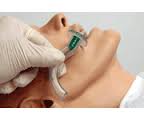Safety with oxygen
- Always check that the cylinder is clean
- Ensure the cylinder is black with white shoulders
- Always use the correct yoke with pressure gauges
- Ensure the bodock seal ( 'O' ring) and valve seat are clean and undamaged
- Store cylinders upright and secure
- Adhere to government regulations regarding the storage of oxygen cylinders
- Store full and empty cylinders separately.
- Mark empty cylinders clearly
- Ensure you are qualified prior to using oxygen equipment
- Do not drop or roll cylinders.
- Do not completely empty a cylinder - leave pressure in the cylinder to prevent moisture entering.
- Do not expose cylinders to extreme heat or flame as oxygen aids combustion.
- Do not smoke near oxygen equipment.
- Do not use petroleum based oil or grease products near oxygen equipment
Checking oxygen equipment
Oxygen equipment should be checked regularly for cleanliness and contents.
Daily maintenance and after each use
- Ensure all supplies and spares, such as oxygen masks and seals are available and undamaged
- Check the contents of the cylinder and replace as necessary
Weekly maintenance and after each use
- Inspect the exterior and connector sockets for cracks and signs of damage
- Check the contents of the cylinder and replace as necessary
After each use
- Ensure all supplies and spares, such as oxygen masks, suction tubing, suckers and seals are available and undamaged
- Check the contents of the cylinder and replace as necessary
- Clean the unit
- Replace the masks and airways as necessary

The minimum contents of a portable resuscitation unit should be:
- Oxygen cylinder not less than half full
- Regulator and flow meter (regulator may incorporate the flow meter)
- Oxygen therapy mask
- adult
- child
- Oxygen therapy tubing
- Resuscitation mask
- adult
- child
- Oxygen cylinder key-wheel
- Spare bodock seal
Additional supplies may include:
- Suction unit (manual or oxygen powered)
- Oropharyngeal airways sizes 1- 4
Oropharyngeal airway
An oropharyngeal airway is a plastic or compound device, shaped in a curve and designed to fit into a casualty's mouth over the tongue to establish and maintain an open airway. The oropharyngeal airway should be used on an unconscious casualty without a 'gag reflex' and is essential when using a mechanical resuscitator.
Prior to inserting the airway, take care to ensure the airway is clear of any obstruction such as vomit, water, etc. Ensure the correct size airway is inserted and should the casualty 'gag' or attempt to reject the airway, remove it immediately.
Method of insertion
- Select the correct size airway by measuring the airway from the point of the ear to the chin
- Hold the casualty's mouth open and with the airway curve towards the nose, insert it to approximately half its length
- Rotate the airway 180 degrees and push gently so that it clears the tongue
- The lip of the airway should be external to the casualty's lips
- Ensure the casualty's head is extended and that no soiling of the oropharynx has occurred
Administering oxygen
By face mask
- Reassure the casualty
- Explain the need for oxygen therapy
- Explain that the oxygen mask will assist with breathing
- Turn on oxygen
- Select mask (adult or child)
- Connect oxygen tubing to mask
- Connect oxygen tubing to flow meter
- Turn on flow meter to appropriate rate (lpm)
- Place mask comfortably over casualty's face covering the mouth and nose
- Adjust straps
- Adjust metal strip over nose
- Continue to reassure the casualty
- Continue to observe the casualty
By nasal prongs
- Reassure the casualty
- Explain the need for oxygen therapy
- Explain that the prongs will assist with breathing
- Turn on oxygen
- Select appropriate size nasal prongs
- Connect oxygen tubing to flow meter
- Turn on flow meter to appropriate rate (lpm)
- Place tips into casualty's nostrils
- Place tubing over and then under casualty's ears
- Adjust for comfort
- Secure tubing to casualty's clothing
- Continue to reassure the casualty
- Continue to observe the casualty